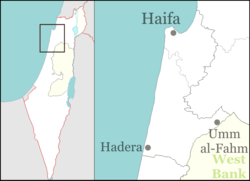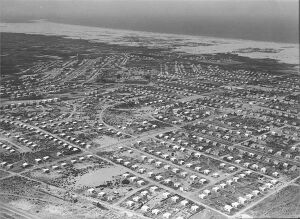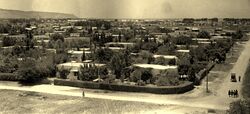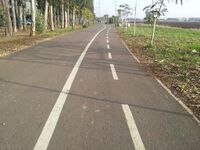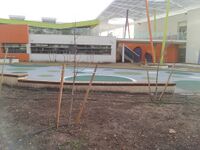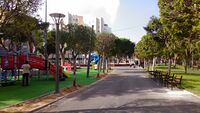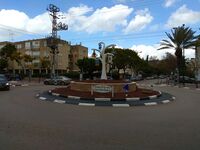كريات بياليك
كريات بياليك
קִרְייַת בְּיַאלִיק | |
|---|---|
| الترجمة اللفظية بالـ Hebrew | |
| • ISO 259 | Qiryat Byáˀliq (Bialik) |
 | |
| الإحداثيات: 32°50′N 35°05′E / 32.833°N 35.083°E | |
| البلد | |
| المنطقة | |
| التأسيس | 1934 |
| الحكومة | |
| • العمدة | إيلي دوكورسكي |
| المساحة | |
| • الإجمالي | 8٬178 dunams (8٫178 كم² or 3٫158 ميل²) |
| التعداد (2023)[1] | |
| • الإجمالي | 44٫970 |
| • الكثافة | 5٫5/km2 (14/sq mi) |
| معنى الاسم | بلدة بياليك |
| الموقع الإلكتروني | www |
كريات بياليك (بالعبرية: קִרְייַת בְּיַאלִיק، حرفياً قرية بياليك، إنگليزية: Kiryat Bialik) is a city in the Haifa District in Israel. The city was established on July 18, 1934, during the Fifth Aliyah, and was initially called 'German Immigrants' Neighborhood'. It is one of the five Krayot suburbs to the north of Haifa. In 2019 it had a population of 40,231.[1]
سُميت المدينة على اسم الشاعر حاييم نحمان بياليك.
. . . . . . . . . . . . . . . . . . . . . . . . . . . . . . . . . . . . . . . . . . . . . . . . . . . . . . . . . . . . . . . . . . . . . . . . . . . . . . . . . . . . . . . . . . . . . . . . . . . . . . . . . . . . . . . . . . . . . . . . . . . . . . . . . . . . . . . . . . . . . . . . . . . . . . . . . . . . . . . . . . . . . . . .
التاريخ
In 1924, Ephraim and Sabina Katz, who had immigrated to Mandatory Palestine from the Kingdom of Romania, were the first Jews in modern times to settle in the Zevulun Valley along the Haifa Bay. Their farm was destroyed in the 1929 Palestine riots. The one house that survived the riots, Beit Katz, was bequeathed to Kiryat Bialik in 1959 and designated for public use.[2]
The town of Kiryat Bialik was founded in July 1934 by a group of German Jewish immigrants who had received a plot of land from the Jewish National Fund. The residents were mainly free professionals, doctors, engineers and lawyers who lived in private homes with gardens. During World War II, Kiryat Bialik was bombed due to its proximity to the oil refineries in Haifa.
In 1950, it was declared a local council, attaining city status in 1976.[3]
During World War II, parts of the settlement were bombed due to its proximity to nearby oil refineries.
In the early 1950s, the 'Ir HaMifratz' transit camp (also called 'Cordani A') was established, where among others, about 100 families of immigrants from India were absorbed. The transit camp was annexed to Kiryat Bialik in 1960."
During the Second Lebanon War, several rockets landed in the city, causing property damage and injuring a number of residents."
الحكومة المحلية
العمد
- he (Zvi Karliner) (1945-1985);
- he (Danny Zack) (1985-2003);
- he (Rafi Wertheim) (2003-2008);
- he (Eli Dukorsky) (2008-)[4]
الأحياء
- Bialik South - the southern neighborhood of Kiryat Bialik. In this neighborhood, he (Ort Kiryat Bialik) was established, the largest school in Israel.
- Sabinia - named after Sabina Katz[5] - was established in the 1930s. Sabinia Center is nowadays a shopping center.
- he (Tzur Shalom) - the northern neighborhood in Kiryat Bialik. At the time of its establishment, it was inhabited mainly by immigrants. To the north of it is an extensive area of light industry.
- The Butterfly - a neighborhood established at the beginning of the 21st century. The neighborhood is named after its shape, the streets of the neighborhood and the buildings in it form the shape of a butterfly.
- HE (Rakafot Hill) - Firstly populated in 2005, and located in eastern part of the city, close by to Kiryat Ata. The name of the neighborhood translates to Primrose Hill in English.
- HE (Neot Afek) - a new neighborhood located in the east of Kiryat Bialik. It is near the Ein Afek Nature Reserve, Nahal Naaman and Tzur Shalom neighborhood.
الديموغرافيا
According to CBS, the ethnic makeup of Kiryat Bialik in 2008 was all Jewish, without a significant Arab population. There were 17,900 males and 19,200 females. In 2003 25.8% of the population was 19 years of age or younger, 15.8% between 20 and 29, 17.4% between 30 and 44, 21.5 from 45 to 59, 3.8% from 60 to 64, and 15.6% 65 years of age or older. The population growth rate in 2005 was -0.3%.The city is ranked medium-high on the socio-economic scale (7 out of 10)[6] Many Jewish immigrants have settled in Kiryat Bialik from Ethiopia, the former Soviet Union and Argentina.
الاقتصاد
According to CBS figures for 2002, there were 17,514 salaried workers and 912 self-employed in Kiryat Bialik. The mean monthly wage for a salaried worker was 6,119 NIS; salaried males had a mean monthly wage of 7,851 NIS versus 4,491 NIS for females The mean income for the self-employed was 5,996 NIS. 557 people received unemployment benefits and 2,701 people received a guaranteed minimum income.
The town was known for the Ata textile factory, established in 1934 by Erich Moller.[7]
The Ata plant, which opened in 1934, became an icon of the Israeli textile industry. It suffered from financial problems in the 1960s and closed down in 1985.[8]
التعليم
According to CBS, there are 9 schools and 6,291 students in the city: 6 elementary schools with 2,540 students, and 3 secondary education schools (2 junior high and 1 high school, under the same administration) with 3,751 students. 63.4% of 12th grade students were entitled to a Bagrut (matriculation) certificate in 2002.
حرب لبنان 2006
During the Second Lebanon War in 2006, the city suffered hits from 15 Katyushas and other types of rockets sent by Hezbollah.[9]
الترفيه
In the city, there is a HE ( municipal library) with two branches, one in the Tzur Shalom area and one in the old Bialik area. The city has two "HE (Pisgah Center)", where various classes for children and teenagers, events, and performances are held.
The "Afek Country Club" in the city features swimming pools and gyms. In 2019, the Yagur swimming pool was closed after 58 years of operation.[10]
Every year in May, the city hosts the "Bialik Festival for Literature and Poetry," which includes cultural performances, meetings with authors, concerts, and children's plays.
Three youth movements operate in Kiryat Bialik: Scouts, HaNoar HaOved VeHaLomed, and HaMahanot HaOlim.
Kiryat Bialik operates a conservatory for music studies and voice development and also has the "Young Bialik" youth band, which performs in Israel and abroad.
The city has a museum dedicated to the history of the city, located in Beit Katz, known as Museum of the History of Kiryat Bialik.
Additionally, within the city is the HE (Kiryon Shopping Mall), one of the largest shopping malls in the country and the largest in the north.
The city has a promenade named after Shimon Peres along the Gedora stream, stretching over several kilometers, starting from Rabin Square in the north to HaEmekim Street in the south of the city. Additionally, there are several parks throughout the city, including: Savyon Garden, which once housed the Savyon Cinema, Miriam Garden, Esther Park, HaBanim Park in the Afek neighborhood, and a park named after Ariel Sharon in the Tzur Shalom neighborhood.
أبرز السكان
- Netanel Artzi (born 1997), Israeli basketball player
- رونن برگمن (و. 1972)، صحفي استقصائي ومؤلف
- Shani Bloch (born 1979), Olympic racing cyclist
- Anastasia Gorbenko (born 2003), swimmer
- Aviv Kochavi (born 1964), Israel Defense Forces Chief of Staff[11]
- Amnon Pazy (1936–2006), mathematician; President of the Hebrew University of Jerusalem
- Revital Sharon (born 1970), Olympic artistic gymnast
- Moti Taka (born 1997), singer
- Zehava Vardi, Miss Israel 1977
- Yochanan Vollach (born 1945), association football player
المدن الشقيقة
Kiryat Bialik is twinned with:[12]
 Hlybokaye, Belarus
Hlybokaye, Belarus İsmayıllı, Azerbaijan
İsmayıllı, Azerbaijan Radomsko, Poland
Radomsko, Poland Rosh HaAyin, Israel
Rosh HaAyin, Israel Steglitz-Zehlendorf (Berlin), Germany
Steglitz-Zehlendorf (Berlin), Germany Chemnitz, Germany
Chemnitz, Germany Zakynthos, Greece
Zakynthos, Greece Zestaponi, Georgia
Zestaponi, Georgia
. . . . . . . . . . . . . . . . . . . . . . . . . . . . . . . . . . . . . . . . . . . . . . . . . . . . . . . . . . . . . . . . . . . . . . . . . . . . . . . . . . . . . . . . . . . . . . . . . . . . . . . . . . . . . . . . . . . . . . . . . . . . . . . . . . . . . . . . . . . . . . . . . . . . . . . . . . . . . . . . . . . . . . . .
معرض الصور
المصادر
- ^ أ ب "Population in the Localities 2019" (XLS). Israel Central Bureau of Statistics. Retrieved 16 August 2020.
- ^ Katz Gardens, Kiryat Bialik
- ^ "The History of the Town - A True Story". Archived from the original on 2011-08-15. Retrieved 2012-03-25.
- ^ Municipality of Kiryat Bialik
- ^ "דור לדור בית כץ" (in الإنجليزية الأمريكية). Retrieved 2023-02-19.
- ^ http://www.cbs.gov.il/www/publications/local_authorities2003/pdf/t02.pdf[bare URL PDF]
- ^ Ata: Factory, Fashion Dream
- ^ When the guns fell silent, Haaretz
- ^ "קריית ביאליק: שלטים במקומות נפילת הקטיושות". Ynet (in العبرية). 2007-07-13. Retrieved 2016-03-14.
- ^ Penhas, Mirit (April 21, 2019). "Bialik: The Mythological Yagur Pool Closes After 58 Years". mynet.
- ^ "Krayot website article".
- ^ "ערים תאומות". qbialik.org.il (in العبرية). Kiryat Bialik. Retrieved 2020-02-24.
- Pages using gadget WikiMiniAtlas
- CS1 الإنجليزية الأمريكية-language sources (en-us)
- All articles with bare URLs for citations
- Articles with bare URLs for citations from March 2022
- Articles with PDF format bare URLs for citations
- CS1 العبرية-language sources (he)
- Short description is different from Wikidata
- Articles containing عبرية-language text
- Coordinates on Wikidata
- Articles containing إنگليزية-language text
- Pages using Lang-xx templates
- منطقة حيفا
- مدن إسرائيل
- كرايوت
- مدن منطقة حيفا
- أماكن مأهولة تأسست في 1934
- تأسيسات 1934 في فلسطين الانتدابية

